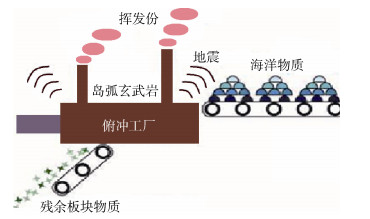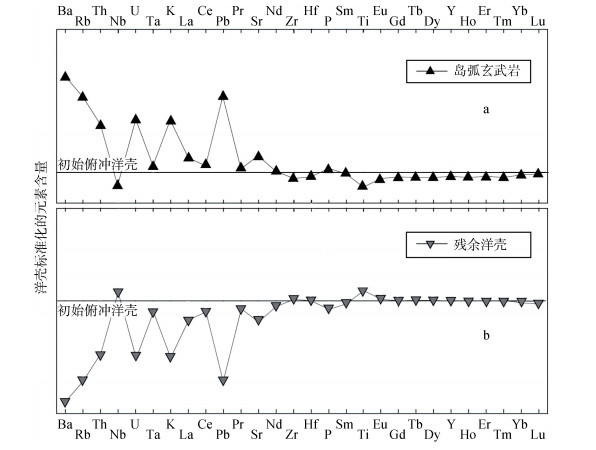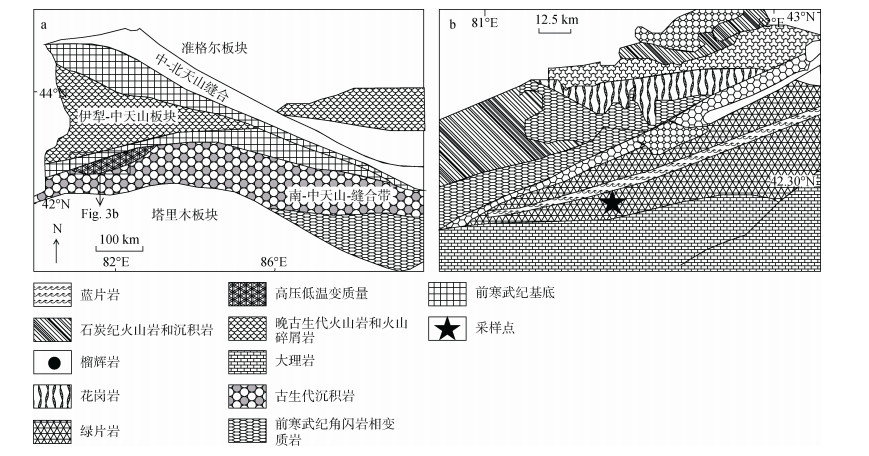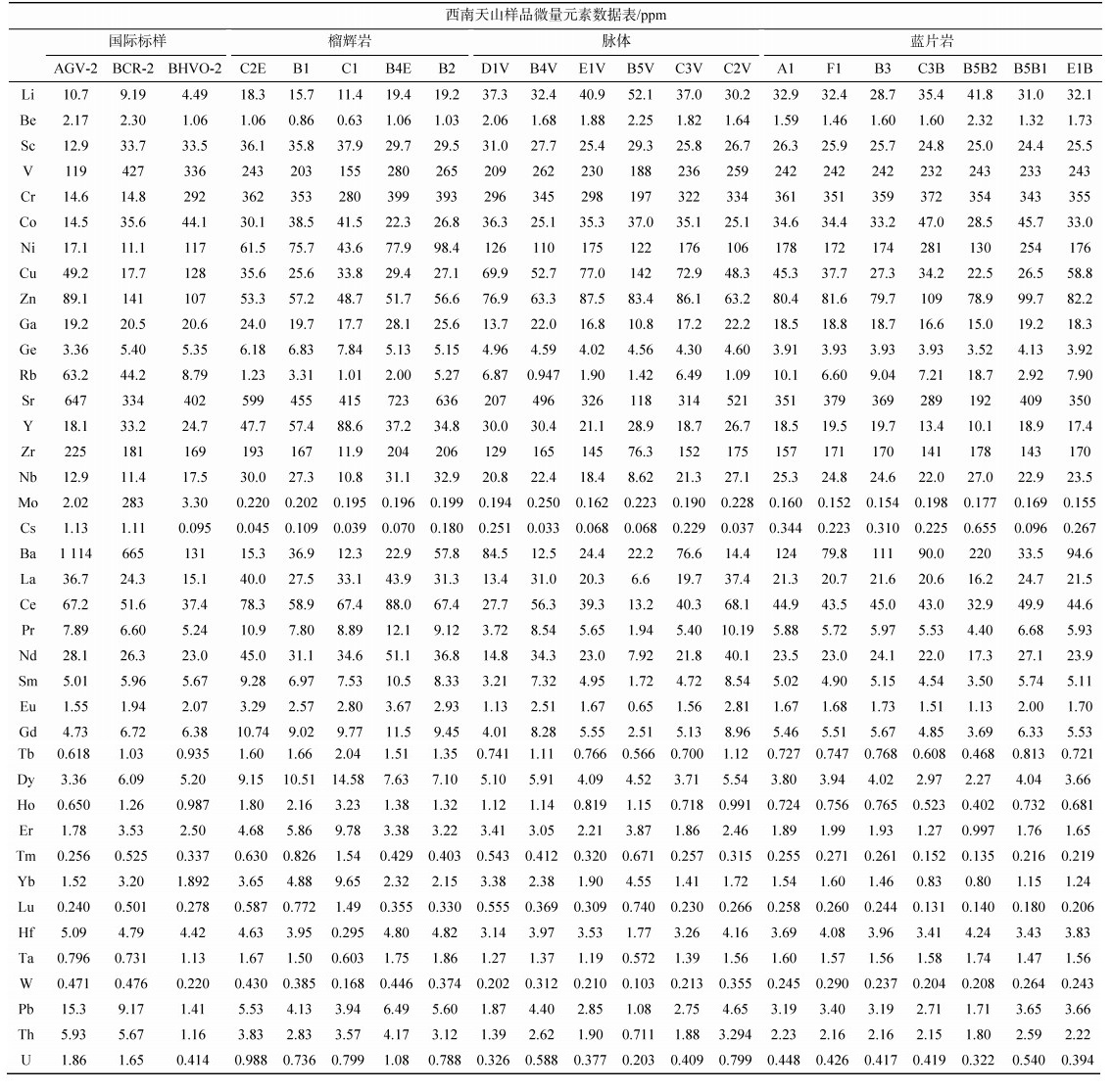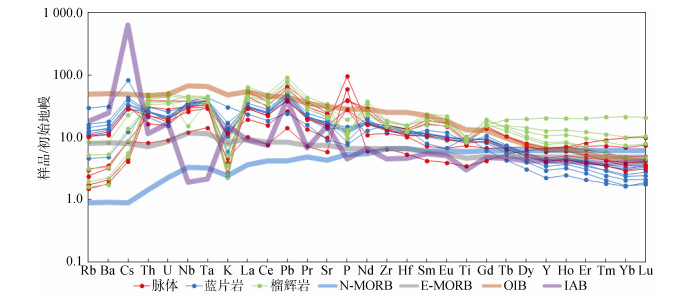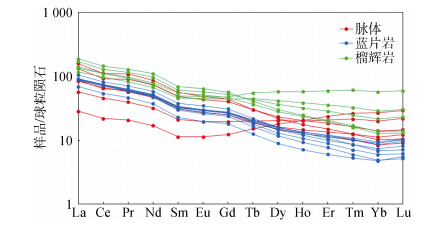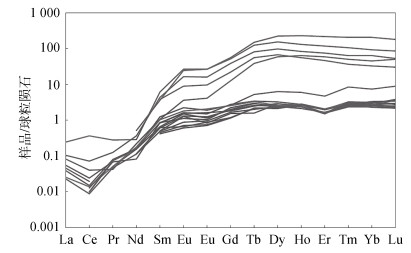文章信息
- 王栋, 肖媛媛, 牛耀龄. 2019.
- WANG Dong, XIAO Yuan-yuan, NIU Yao-ling. 2019.
- 大洋岩石圈俯冲过程中流体活动的岩石地球化学记录:以中国西南天山(超)高压变质带为例
- Petrological and geochemical records of fluid activity during seafloor subduction: constraints from the (ultra) high-pressure metamorphic belt of Southwestern Tianshan, China
- 海洋科学, 43(12): 1-16
- Marine Sciences, 43(12): 1-16.
- http://dx.doi.org/10.11759/hykx20190123002
-
文章历史
- 收稿日期:2019-01-23
- 修回日期:2019-03-19
2. 青岛海洋科学与技术国家实验室, 山东 青岛 266061;
3. 中国科学院大学, 北京 100049;
4. 中国科学院海洋大科学研究中心, 山东 青岛 266071;
5. 杜伦大学地球科学系, 英国 杜伦DH1 3LE;
6. 中国地质大学地球科学与矿产资源学院, 北京 100083
2. Laboratory for Marine Geology, Qingdao National Laboratory for Marine Science and Technology, Qingdao 266061, China;
3. University of Chinese Academy of Sciences, Beijing 100049, China;
4. Center for Ocean Mega-Science, Chinese Academy of Sciences, Qingdao 266071 China;
5. Department of Earth Sciences, Durham University, Durham, DH1 3LE, UK;
6. School of Earth Science and Resources, China University of Geosciences, Beijing 100083, China
大洋岩石圈俯冲是板块运动的直接驱动力, 并与俯冲带地震活动、大型成矿作用息息相关[1-2], 而俯冲带本身是地球表层与深部地幔之间物质、能量交换最活跃的场所, 有“俯冲工厂”之称[2](图 1)。传统观点认为, 大洋岩石圈在俯冲过程中所释放的水流体选择性携带K、Rb、Cs、Ba、Pb、Sr、U等水溶性元素(活动性元素)进入上覆地幔楔, 造成岛弧岩浆(IAB)富集相应元素(图 2), 非水溶性元素(不活动性元素, 如Nb、Ta、Zr、Hf、Ti等)则保存在残余俯冲板块中、被带入深部地幔, 导致地幔组成的不均一性[3-5]。
俯冲带变质岩是揭示大洋岩石圈俯冲过程最直接的研究对象。传统观点认为俯冲洋壳由蓝片岩相向榴辉岩相转变过程中会释放大量水流体、并携带几乎所有的水溶性元素迁移[6], 但是近十多年来有学者发现, 硬柱石和多硅白云母等矿物可以在超高压变质条件下(> 2.5 GPa, 约相当于75 km俯冲深度)稳定存在[7], 并且可以极大程度保存它们喜欢的元素, 从而影响相应元素的地球化学行为[8-15]。可见, 大洋岩石圈俯冲过程中元素的地球化学行为十分复杂[13, 16-20]。其中, 在俯冲带开放体系下, 流体对元素地球化学行为以及物质迁移过程的影响很大--流体的物理化学性质会影响其携带元素的能力, 如超临界流体可以极大提高元素的活动性[21-22], 而流体的含量和流动特征也会影响元素的活动性, 如俯冲隧道机制内的大规模流体可以提高元素的活动性[16, 23-24]。因此, 有必要深入研究俯冲变质岩中的流体记录, 探讨流体在大洋岩石圈俯冲变质作用中的影响[9-13, 25]。例如, 近年在对西南天山榴辉岩的研究中发现流体可以引起氧同位素在不同矿物中的不均匀分馏等[26]。
本研究主要以采自中国西南天山超高压变质带的岩石为例, 通过岩石学与地球化学研究, 分析大洋岩石圈俯冲过程中元素的地球化学行为和存在的流体记录, 进一步探讨俯冲带流体性质和流体对俯冲带地球化学过程的地质意义。
2 地质背景天山造山带东起新疆北部, 穿越哈萨克斯坦、吉尔吉斯斯坦和塔吉克斯坦, 西至乌兹别克斯坦[27]。其中, 高压-超高压变质带在南天山造山带中延伸近1 500公里, 从新疆的科克苏河、阿克牙孜沟和长阿吾子沟, 向西经由吉尔吉斯斯坦的阿特巴什(Atbashy)榴辉岩-蓝片岩带与塔吉克斯坦境内的范-卡拉特金(Fan-Karategin)蓝片岩-绿片岩带相连接[27-28], 是全球典型的大洋岩石圈俯冲变质带代表之一。
我们的研究区位于新疆西南天山高压-超高压变质带(图 3), 位于伊犁-中天山板块和塔里木板块间200公里长的造山带中[31], 该变质带被认为是南天山古洋盆在古生代闭合过程中塔里木板块向伊犁-中天山板块方向发生俯冲而形成[27, 32]。主要岩石组成有榴辉岩、蓝片岩、白云母片岩和绿片岩等。根据地球化学特征, 原岩可能包括洋岛玄武岩(OIB)、富集型洋中脊玄武岩(E-MORB)、正常洋中脊玄武岩(N-MORB)等大洋玄武岩, 反映了洋壳俯冲环境[10, 33]。
西南天山峰期变质温度470~510℃, 由于发现柯石英等超高压变质矿物, 指示该变质带的最高变质压力可达2.4~2.7 GPa, 即俯冲深度超过75 km[34-36]。近年来不同学者利用各种方法限定西南天山造山带变质年龄, 包括Ar/Ar法, Rb/Sr、Sm/Nd、Lu/Hf等时线法和原位锆石U-Pb定年等[29-30, 37-38], 得到的峰期变质年龄介于340-320 Ma。西南天山蓝片岩-榴辉岩中分布有大量脉体, 由于脉体被认为代表了流体曾经运移的通道, 所以这些岩石记录了曾经丰富的流体活动[15, 39]。
3 岩石学特征俯冲带变质岩样品的矿物组合与结构关系记录流体作用的信息, 并可用来反演变质历史。根据矿物组成和结构特征, 我们将采自西南天山的岩石样品分为三部分:石榴子石、绿辉石富集的榴辉岩部分, 蓝闪石和帘石富集的蓝片岩部分, 以及脉体部分(图 4)。
 |
| 图 4 手标本照片, 根据矿物组成可以分为榴辉岩、蓝片岩和脉体(a); 手标本初次切割后与薄片一一对应(b) Fig. 4 Photographs of the hand specimen. The sample consists mainly of eclogite, blueschist, and veins; (a) the sample after cut up corresponding to slides (b) |
榴辉岩部分的主要矿物组成为石榴子石(~60%)、绿辉石(~15%), 此外, 还有一些蓝闪石(~5%)、帘石族矿物(~15%)、白云母(~5%)等(图 5a-f)。其中少量石榴子石被云母、蓝闪石等含水矿物取代(图 5c-f), 仅局部富集帘石(图 5b)。可见, 该部分达到了榴辉岩相, 并只经历了低程度的水化作用改造。蓝片岩部分主要由蓝闪石(~35%)、帘石族矿物(~20%)组成, 此外, 还有一些石榴子石(~15%)、绿辉石(~15%)、白云母(~15%)等(图 6a), 与榴辉岩部分之间无明显界限, 含水矿物逐渐增多, 无水矿物逐渐减少。并且蓝片岩部分普遍存在含水矿物取代无水矿物的现象, 例如白云母取代石榴子石(图 6b), 蓝闪石取代绿辉石等(图 6c)。残余的石榴子石和绿辉石说明蓝片岩部分与榴辉岩部分相同, 也曾经历过榴辉岩相变质作用, 而普遍存在的含水矿物取代现象和蓝闪石、帘石族矿物的组合说明该部分相较榴辉岩部分历经了更高程度的水化作用、已改造为蓝片岩相。脉体部分主要由绿辉石(~50%)、帘石(~15%)、蓝闪石(~10%)组成(图 7a), 此外还有一些白云母(~10%)、石榴子石(~5%)、磷灰石(~5%)和碳酸盐矿物(~5%)(图 7b-f)。脉体中取代现象显著, 白云母取代绿辉石(图 7b), 蓝闪石取代石榴子石和帘石(图 7c, d)。石榴子石和绿辉石等在含水矿物中的存在说明脉体部分也曾达到榴辉岩相, 而含水矿物普遍出现以及蓝闪石、帘石主要分布在脉体的边部则都反映了流体影响的水化作用改造过程(图 7a)。此外, 在脉体中还发现一些晶形较好的碳酸盐矿物和磷灰石(图 7e, f), 根据碳酸盐矿物和磷灰石仅在脉体中存在且包裹绿辉石的特点, 我们认为这些碳酸盐矿物和磷灰石指示在榴辉岩相变质阶段有富CO2和P流体的介入。
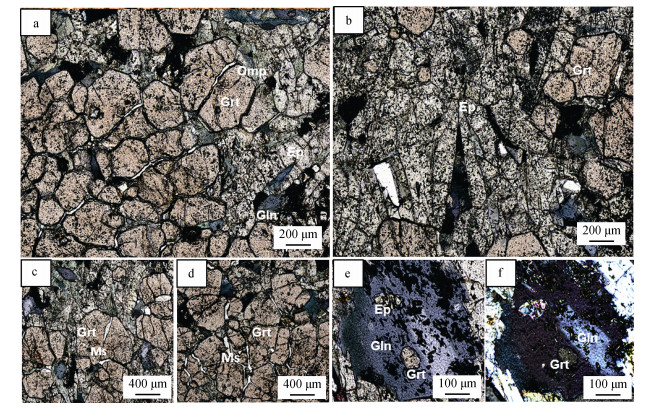 |
| 图 5 榴辉岩部分薄片镜下照片 Fig. 5 Photomicrographs of eclogite sections 注: a-e为单偏光, f为正交偏光。a:主要矿物组成为石榴子石(Grt)、绿辉石(Omp); b:仅局部存在帘石(Ep)富集; c、d:石榴子石晶形被白云母(Ms)破坏; e、f:蓝闪石(Gln)取代石榴子石和帘石 |
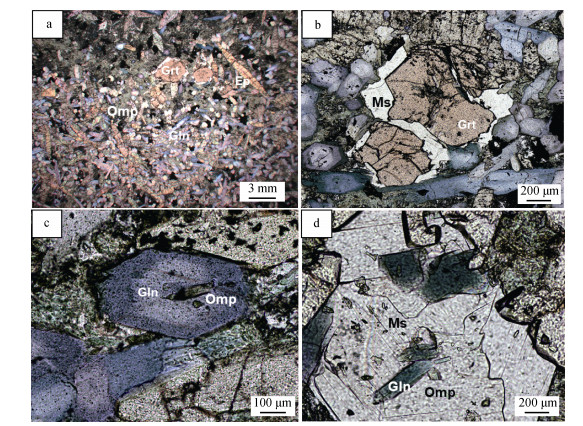 |
| 图 6 蓝片岩部分薄片镜下照片 Fig. 6 Photomicrographs of blueschist sections 注: a:主要矿物组成为蓝闪石(Gln)、帘石(Ep); b:白云母(Ms)取代石榴子石; c:蓝闪石(Gln)取代绿辉石(Omp); d:白云母(Ms)取代绿辉石(Omp)、蓝闪石(Gln) |
 |
| 图 7 脉体部分薄片镜下照片 Fig. 7 Photomicrographs of vein 注: a-b为单偏光, c-f为正交偏光。a:主要矿物组成为绿辉石(Omp), 边部富集蓝闪石(Gln)、帘石(Ep); b:白云母(Ms)取代绿辉石(Omp); c:蓝闪石(Gln)取代帘石(Ep); d:蓝闪石(Gln)取代石榴子石(Grt); e:存在碳酸盐矿物(Cb); f:存在磷灰石(Ap) |
矿物组合和结构特征表明该样品记录了两个阶段的变质作用:第一阶段, 榴辉岩化作用, 使所有样品达到了榴辉岩相; 第二阶段, 由于外来流体的加入, 样品的不同部分发生了不同程度的水化改造, 其中在空间分布上距离脉体更远的榴辉岩部分水化改造程度较低, 距离脉体更近的蓝片岩部分水化改造程度高。
4 地球化学分析方法本研究的全岩主微量元素、Sr-Nd-Hf同位素、激光原位分析均在中国科学院海洋研究所大洋岩石圈与地幔动力学超净实验室完成。主量元素采用碱熔法, 取40~50 mg的200目粉末样品烘干, 放在铂金坩埚中与200 mg偏硼酸混合, 在马弗炉中1 050℃条件下加热约3-4小时至熔融, 倒入盛有约50 mL的5%硝酸的烧杯中, 超声至溶液均匀, 最后转移到样品瓶中定容稀释至约样品称重的2 000倍。主量元素测试使用Agilent-5100型电感耦合等离子体发射光谱仪(Inductively Coupled Plasma Optical Emission Spectrometer, ICP-OES)。所用的监控标样为美国地质调查局岩石标样AGV-2和BCR-2。详细分析方法见Kong等[40]。主量元素分析精度和准确度优于5%, 分析结果见表 1。微量元素采用混合酸溶样法, 称50 mg粉末样品于Teflon杯中, 依次添加1 mL反王水、0.5 mL HF。经过初溶、赶酸、复溶、定容等步骤得到约100 g(稀释约2 000倍)溶液等待分析测试。样品微量元素测定选用Agilent 7900型四极杆电感耦合等离子体质谱仪(ICP-MS)进行测定, 分析精度优于5%、准确度优于10%, 详细分析流程见Chen等[41]。矿物含量分析使用激光剥蚀电感耦合等离子体质谱仪(Laser Ablation Inductively Coupled Plasma Mass Spectrometer, LA-ICP-MS), 由Photon-machines公司生产的193 nm准分子激光剥蚀系统Analyte Excite和Agilent-7900型电感耦合等离子体质谱仪组成, 剥蚀斑束直径40 μm, 分析过程中, 采用国际标样GSE-1、SRM 610、BIR-1G、BHVO-2、BCR-2校正, 详细步骤见Xiao等(待发表)[42]。全岩Sr-Nd-Hf同位素测试采用Nu公司生产的多接收电感耦合等离子体质谱仪(Multi-Collector Inductively Coupled Plasma Mass Spectrometer, MC-ICP-MS), 样品消解、Sr-Nd-Hf元素分离流程和分析方法详见Sun等[43]。所有87Sr/86Sr、143Nd/144Nd和176Hf/177Hf测量值分别进行质量分馏校正到86Sr/88Sr=0.119 4, 146Nd/144Nd = 0.721 9及179Hf/177Hf = 0.732 5。同位素标样分析结果为: NBS987 Sr为87Sr/86Sr=0.710 209±26, JNdi-1 Nd为143Nd/144Nd=0.512 116±9, Alfa Hf为176Hf/ 177Hf=0.282 209±20。
| 西南天山样品主量元素含量表/% | ||||||||||||
| 样品号 | SiO2 | Al2O3 | CaO | Fe2O3 | K2O | MgO | MnO2 | Na2O | P2O5 | TiO2 | 合计 | |
| 标样 | AGV-2 | 58.82 | 16.74 | 5.29 | 6.76 | 2.47 | 1.84 | 0.10 | 4.50 | 0.51 | 0.89 | 97.91 |
| BCR-2 | 53.85 | 13.46 | 7.32 | 14.01 | 1.45 | 3.73 | 0.20 | 3.36 | 0.38 | 1.99 | 99.78 | |
| 脉体 | B4V | 46.08 | 15.44 | 17.04 | 10.37 | 0.07 | 4.18 | 0.10 | 3.62 | 0.87 | 1.78 | 99.54 |
| E1V | 48.37 | 12.48 | 14.60 | 9.64 | 0.12 | 5.58 | 0.08 | 4.40 | 0.93 | 1.51 | 97.73 | |
| C2V | 43.52 | 14.85 | 17.42 | 9.96 | 0.08 | 4.43 | 0.10 | 3.30 | 0.85 | 1.91 | 96.41 | |
| C3V | 46.91 | 13.00 | 14.47 | 9.57 | 0.34 | 5.74 | 0.09 | 4.25 | 0.61 | 1.74 | 96.71 | |
| B5V | 45.84 | 9.84 | 15.01 | 12.19 | 0.14 | 6.09 | 0.20 | 5.11 | 1.30 | 0.74 | 96.46 | |
| D1V | 46.52 | 12.28 | 13.71 | 11.95 | 0.31 | 5.35 | 0.20 | 3.88 | 0.60 | 1.61 | 96.41 | |
| 榴辉岩 | C2e | 41.37 | 18.45 | 16.57 | 14.25 | 0.08 | 3.19 | 0.26 | 1.84 | 0.21 | 2.05 | 98.27 |
| B1 | 40.74 | 18.26 | 14.33 | 16.91 | 0.15 | 3.43 | 0.39 | 1.64 | 0.28 | 1.81 | 97.96 | |
| B4e | 41.86 | 18.21 | 17.68 | 10.73 | 0.11 | 3.08 | 0.12 | 2.01 | 0.22 | 2.12 | 96.14 | |
| B2 | 41.95 | 18.03 | 16.96 | 11.17 | 0.23 | 3.46 | 0.14 | 1.98 | 0.42 | 2.16 | 96.50 | |
| C1 | 38.98 | 18.37 | 13.81 | 19.54 | 0.07 | 3.12 | 0.55 | 1.18 | 0.25 | 1.80 | 97.67 | |
| 蓝片岩 | B3 | 49.83 | 13.96 | 13.13 | 8.77 | 0.41 | 4.90 | 0.06 | 3.48 | 0.18 | 1.94 | 96.67 |
| A1 | 50.75 | 13.89 | 13.08 | 8.79 | 0.52 | 5.00 | 0.07 | 3.74 | 0.32 | 2.07 | 98.22 | |
| B5b1 | 48.27 | 13.79 | 12.33 | 9.11 | 0.18 | 5.54 | 0.05 | 3.82 | 0.27 | 1.80 | 95.15 | |
| E1b | 50.14 | 13.64 | 13.32 | 8.70 | 0.42 | 5.12 | 0.05 | 3.85 | 0.28 | 2.00 | 97.51 | |
| C3b | 49.11 | 12.96 | 11.70 | 8.93 | 0.31 | 6.44 | 0.05 | 4.31 | 0.31 | 1.95 | 96.07 | |
| B5b2 | 50.33 | 11.70 | 12.99 | 7.65 | 0.92 | 5.39 | 0.04 | 4.42 | 0.16 | 2.19 | 95.79 | |
| F1 | 49.13 | 13.94 | 13.12 | 8.67 | 0.37 | 4.85 | 0.06 | 3.56 | 0.27 | 1.93 | 95.90 | |
岩石样品三部分的主量元素分析结果见表 1, 不同部分表现出明显的元素含量差异。榴辉岩部分中Mn、Al、Fe的含量明显高于蓝片岩部分和脉体部分中的含量, 如在榴辉岩中三种元素氧化物的含量分别为0.12%~0.55%(相较于0.04%~0.2%)、18.03%~ 18.45%(相较于9.84%~15.44%)和10.73%~19.54%(相较于7.65%~12.19%)。考虑到榴辉岩部分较蓝片岩部分、脉体显著含有更多的石榴子石, 这三种氧化物的含量变化反映石榴子石在三部分之间的差异(图 5a, 6a, 7a)。脉体中P2O5的含量(0.6%~1.3%)明显高于榴辉岩和蓝片岩中的含量(0.16%~0.42%)。作为磷灰石的主量元素, P2O5的含量变化与在脉体中有大量磷灰石相符(图 7f)。蓝片岩中K2O的含量明显(0.18%~ 0.92%)高于榴辉岩和脉体中的含量(0.07%~0.34%)。K作为白云母的主量元素, 在蓝片岩中的较高含量与白云母在水化程度较高部分中普遍存在的现象一致。因此, 主量元素在岩石样品中不同部分的变化主要反映了相应矿物的分布变化。
5.2 微量元素分析结果微量元素的测试结果见表 2。三部分样品的Rb、Ba、Cs含量变化较大, 其中蓝片岩部分中Rb(2.92~ 18.75 ppm)、Cs(0.1~0.65 ppm)、Ba(33.56~220.3 ppm)的含量明显高于榴辉岩部分中Rb(1.01~5.28 ppm)、Cs(0.04~0.18 ppm)、Ba(12.31~57.82 ppm)和脉体部分中Rb(0.95~6.88 ppm)、Cs(0.03~0.25 ppm)、Ba(12.57~ 84.54 ppm)的含量。在微量元素的初始地幔标准化蛛网图(图 8)中, 蓝片岩的Rb、Ba、Cs、K等水溶性元素含量明显高于榴辉岩和脉体中的含量, 而Nb、Ta、Zr、Hf的含量在榴辉岩部分、脉体部分、蓝片岩部分中基本没有变化, 且无亏损现象。稀土元素球粒陨石标准化蛛网图(图 9)显示三部分岩石样品整体富集轻稀土, 而相较于蓝片岩和脉体, 榴辉岩中的稀土含量、尤其是重稀土含量较高, 个别脉体中的重稀土含量异常高。
5.3 激光原位分析结果
我们对样品中的白云母、石榴子石等矿物进行了激光原位分析, 结果见表 3、表 4, 激光原位分析结果显示白云母中Rb含量可以高达210~230 ppm, Cs含量可以高达4.86~6.06 ppm, Ba含量可以高达2 532~2 835 ppm, 可见, 白云母是全岩Rb、Cs、Ba的主要载体矿物。而在石榴子石稀土元素的球粒陨石标准化蛛网图中, 石榴子石强烈富集重稀土元素的特征(图 11), 指示重稀土元素的含量与地球化学行为主要受石榴子石控制。
| 白云母中K、Rb、Cs、Ba含量表/ppm | ||||
| K | Rb | Cs | Ba | |
| 白云母.1 | 90 626 | 223 | 5.59 | 2 532 |
| 白云母.2 | 89 844 | 228 | 5.86 | 2 835 |
| 白云母.3 | 90 568 | 230 | 6.06 | 2 701 |
| 白云母.4 | 90 579 | 210 | 4.86 | 2 638 |
| 白云母.5 | 89 549 | 223 | 5.59 | 2 676 |
| 白云母.6 | 88 828 | 209 | 5.77 | 2 212 |
| 白云母.7 | 90 942 | 214 | 5.64 | 2 309 |
| 石榴子石中稀土元素含量表/ppm | |||||||||||||||
| La | Ce | Pr | Nd | Sm | Eu151 | Eu153 | Gd | Tb | Dy | Ho | Er | Tm | Yb | Lu | |
| 石榴石.1 | 0.025 | 0.044 | 0.012 | 0.170 | 0.671 | 0.952 | 0.935 | 7.901 | 3.017 | 25.11 | 4.677 | 12.23 | 1.608 | 10.98 | 1.341 |
| 石榴石.2 | 0.020 | 0.024 | 0.004 | 0.102 | 0.162 | 0.210 | 0.238 | 2.605 | 1.445 | 15.01 | 3.636 | 9.873 | 1.287 | 7.594 | 1.273 |
| 石榴石.3 | 0.049 | 0.000 | 0.242 | 0.552 | 1.425 | 1.528 | 10.48 | 4.627 | 38.49 | 7.498 | 19.50 | 2.675 | 15.86 | 2.189 | |
| 石榴石.4 | 0.005 | 0.000 | 0.000 | 0.576 | 0.512 | 0.559 | 4.512 | 2.105 | 17.26 | 3.124 | 7.734 | 0.918 | 5.627 | 0.761 | |
| 石榴石.5 | 0.057 | 0.220 | 0.027 | 0.133 | 0.947 | 1.520 | 1.519 | 11.34 | 5.591 | 55.92 | 12.79 | 35.62 | 5.289 | 35.12 | 4.576 |
| 石榴石.6 | 0.000 | 0.000 | 0.075 | 0.445 | 0.863 | 1.016 | 7.263 | 3.476 | 29.10 | 5.398 | 12.99 | 1.726 | 10.114 | 1.487 | |
| 石榴石.7 | 0.006 | 0.000 | 0.000 | 0.507 | 0.827 | 0.732 | 6.732 | 2.649 | 20.61 | 3.707 | 9.289 | 1.159 | 6.940 | 1.099 | |
| 石榴石.8 | 0.006 | 0.010 | 0.047 | 0.273 | 0.569 | 0.544 | 4.905 | 1.923 | 17.21 | 2.988 | 7.326 | 0.953 | 4.805 | 0.542 | |
| 石榴石.9 | 0.000 | 0.005 | 0.126 | 0.859 | 1.441 | 1.414 | 9.372 | 6.238 | 76.45 | 20.79 | 70.70 | 11.93 | 79.46 | 9.602 | |
| 石榴石.10 | 0.018 | 0.041 | 0.009 | 0.000 | 0.098 | 0.199 | 0.202 | 1.699 | 1.201 | 14.26 | 3.651 | 10.93 | 1.350 | 9.244 | 1.479 |
| 石榴石.11 | 0.012 | 0.005 | 0.169 | 0.589 | 0.975 | 1.119 | 7.333 | 2.962 | 25.79 | 5.040 | 11.77 | 1.301 | 8.793 | 1.408 | |
| 石榴石.12 | 0.006 | 0.001 | 0.000 | 0.193 | 0.336 | 0.256 | 2.683 | 1.337 | 14.52 | 3.534 | 9.811 | 1.246 | 8.880 | 1.384 | |
| 石榴石.13 | 0.022 | 0.006 | 0.000 | 0.077 | 0.211 | 0.655 | 0.614 | 5.482 | 2.104 | 17.60 | 3.226 | 8.309 | 0.891 | 6.502 | 0.985 |
| 石榴石.14 | 0.005 | 0.005 | 0.000 | 0.075 | 0.292 | 0.091 | 0.272 | 2.128 | 1.228 | 14.61 | 3.566 | 10.57 | 1.466 | 9.284 | 1.231 |
| 石榴石.15 | 0.016 | 0.016 | 0.013 | 0.152 | 0.557 | 0.758 | 0.596 | 4.805 | 2.279 | 17.36 | 3.392 | 8.189 | 1.043 | 6.134 | 0.909 |
| 石榴石.16 | 0.005 | 0.000 | 0.076 | 0.206 | 0.258 | 0.323 | 3.528 | 1.607 | 15.84 | 3.498 | 9.033 | 1.167 | 7.550 | 1.165 | |
| 石榴石.17 | 0.011 | 0.001 | 0.039 | 0.420 | 0.507 | 0.534 | 5.379 | 2.112 | 17.46 | 3.292 | 8.096 | 1.090 | 5.670 | 0.787 | |
| 石榴石.18 | 0.006 | 0.006 | 0.000 | 0.288 | 0.520 | 0.715 | 0.786 | 6.535 | 2.596 | 24.19 | 5.295 | 14.873 | 2.092 | 16.32 | 2.557 |
| 注:空白表示含量低于检测线 | |||||||||||||||
 |
| 图 10 Rb/Nb vs. K/Nb(a), Ba/Nb vs. K/Nb (b), 和Cs/Nb vs. K/Nb(c)散点图 Fig. 10 Rb/Nb vs. K/Nb (a), Ba/Nb vs. K/Nb(b), and Cs/Nb vs. K/Nb (c) plots for sample from Southwestern Tian Shan Orogen 注:蓝片岩Rb、Ba、Cs、K等水溶性元素的含量明显高于榴辉岩中的含量, Rb、Ba、Cs和K有着很好的相关性 |
样品的全岩Sr-Nd-Hf同位素分析结果见表 5。全岩87Sr/86Sr为0.703 962~0.708 445, 143Nd/144Nd为0.512 516 2~0.512 544 7, 176Hf/177Hf为0.282 568~ 0.283 260。得到了Lu-Hf全岩等时线年龄为332±24 Ma (MSWD=1.8), 这与前人得到的西南天山峰期变质年龄(340-320 Ma)一致[30, 38-39]。初始176Hf/177Hf (332 Ma)=0.282 662 6±0.000 008 1。
| 样品名称 | 87Sr/86Sr | 143Nd/144Nd | 176Hf/177Hf | |
| 脉体 | C2v | 0.705 692 | 0.282 723 | |
| E1v | 0.705 767 | 0.512 530 | 0.282 748 | |
| C3v | 0.705 989 | 0.512 528 | 0.282 710 | |
| D1v | 0.706 197 | 0.512 533 | 0.282 809 | |
| B4v | 0.705 716 | 0.512 538 | 0.282 768 | |
| B5v | 0.706 232 | 0.283 035 | ||
| 榴辉岩 | B4e | 0.705 721 | 0.512 544 | 0.282 724 |
| C2e | 0.705 716 | 0.512 531 | 0.282 786 | |
| B1 | 0.705 780 | 0.512 545 | 0.282 841 | |
| B2 | 0.705 994 | 0.512 528 | 0.282 693 | |
| 蓝片岩 | B3 | 0.706 026 | 0.512 527 | 0.282 705 |
| A1 | 0.706 106 | 0.512 519 | 0.282 723 | |
| F1 | 0.705 922 | 0.512 521 | 0.282 734 | |
| E1b | 0.706 012 | 0.512 530 | 0.282 720 | |
| B5b1 | 0.705 782 | 0.512 526 | 0.282 700 | |
| C3b | 0.706 032 | 0.512 524 | 0.282 700 | |
| B5b2 | 0.707 169 | 0.512 516 | 0.282 697 | |
由于大洋岩石圈俯冲变质作用对活动性元素地球化学行为的影响, 通常用Th、Nb、Yb等不易迁移元素示踪变质岩的原岩组成[46]。我们将样品的Th/Yb- Nb/Yb比值与玄武岩不同端元进行对比, 发现样品的Th/Yb、Nb/Yb比值主要分布在OIB附近(图 13)。微量元素的初始地幔标准化蛛网图(图 8)显示样品的Nb、Ta、Zr、Hf等不易迁移元素无亏损, 并且富集轻稀土元素, 亏损重稀土元素(图 9), 与OIB的元素含量特征类似, 所以样品的原岩成分可能类似于OIB。
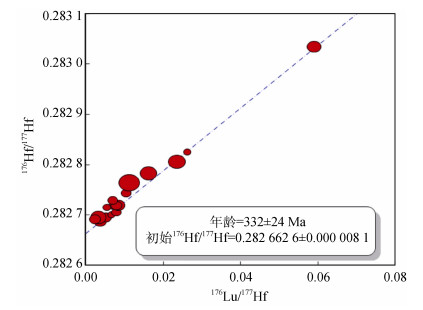 |
| 图 12 样品全岩Lu-Hf等时线 Fig. 12 A diagram of Lu-Hf isochron, Age = 332±24 Ma, initial 176Hf/177Hf = 0.282 662 6 ± 0.000 008 1, MSWD = 1.8. 注: Age=332±24 Ma, 初始176Hf/177Hf=0.282 662 6±0.000 008 1, MSWD=1.8 |
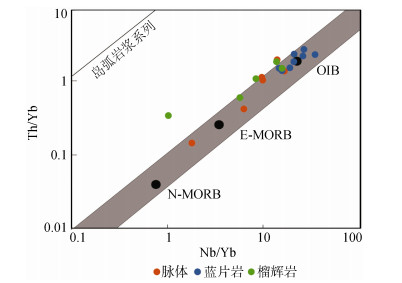 |
| 图 13 样品的Nb/Yb-Th/Yb元素对比值 Fig. 13 Th/Yb versus Nb/Yb for the sample. Ocean-island basalt (OIB), enriched (E)-, and normal (N) mid- ocean-ridge basalt (MORB) are plotted for comparison (black solid circles) 注: 黑色的圆点分别对应E型洋中脊玄武岩(E-MORB), N型洋中脊玄武岩(N-MORB), 洋岛玄武岩(OIB), 我们的样品Th/Yb与Nb/Yb比值主要分布在OIB附近[46] |
前人做过大量工作来探讨西南天山的峰期变质年龄和折返年龄, 包括Ar-Ar定年法, Sm-Nd、Rb-Sr、Lu-Hf等时线法和锆石U-Pb定年等, 目前普遍得到的西南天山峰期变质年龄为340~320 Ma[29-30, 37-38], 但在相同研究区域也有学者通过SHRIMP分析得到了显著年轻的锆石U-Pb年龄, 即233~226 Ma[47]。然而之后的研究认为, 普遍具有更年轻变质年龄锆石的岩石样品缺失绿辉石、多硅白云母等榴辉岩相矿物, 所以这些更年轻的锆石U-Pb年龄可能是由于后期流体作用改造或者锆石颗粒重结晶造成[48]。我们的样品由于经历了相同的峰期变质作用(尽管水化作用的改造程度不同)并且在岩石样品不同部位的矿物组成分布不同, 考虑到不同矿物对元素的不同喜好, 所以每个部位具有不同的元素比值, 从而能够通过综合具有不同元素比值的不同部位样品得到可靠的全岩等时线年龄。通过岩石不同部位的Hf同位素组成, 我们得到Lu-Hf等时线年龄为332±24 Ma(图 4、12)。我们得到的这个年龄为变质作用导致的矿物及元素重新分异的变质年龄, 并不代表原岩年龄。由于Lu、Hf元素在俯冲变质作用过程中的不活动性, 我们认为这一年龄可以代表样品经历峰期变质作用的年龄, 与近年来用SIMS进行U-Pb定年等方法得到的西南天山340~320 Ma的峰期变质年龄相近[29-30, 37-38]。
6.2 俯冲带变质作用过程中元素的地球化学行为与类似于OIB的原岩成分相比, 该岩石不同部位的全岩K、Rb、Cs、Ba含量均较为亏损, 并且这些元素在蓝片岩部分的含量明显高于榴辉岩部分的含量(如图 8)。由于样品主要经历了两个阶段的变质作用, 在第一阶段中, 整个岩石样品经历了榴辉岩相变质作用, 而在第二阶段中, 与榴辉岩比较, 蓝片岩经历了更高程度的水化作用改造。因此, 岩石样品不同部位与原岩成分相比整体所表现的元素亏损反映第一阶段榴辉岩化过程丢失了K、Rb、Cs、Ba, 而岩石样品不同部位之间所表现出这些元素的差异则反映了在第二阶段水化改造中外来流体带来了更多K、Rb、Cs、Ba。元素Rb、Cs、Ba和K具有很好的相关性(图 10), K作为白云母的主量元素, Rb、Cs、Ba与K的相关性指示这些元素在全岩中主要赋存于白云母, 与白云母中较高的Rb、Cs、Ba含量相符(表 3)。因此, 白云母控制K、Rb、Cs、Ba的地球化学行为, 白云母的形成与稳定使这些元素在大洋岩石圈俯冲变质作用过程中成为“不活泼”元素被保留。所以, 与榴辉岩相比, 蓝片岩中含有较多的白云母(图 5、6)反映了外来流体带来的、在蓝片岩中富集的K、Rb、Cs、Ba由蓝片岩中新形成的白云母所控制。因此, 综合岩石学和地球化学, 我们认为:第一阶段, 由于蓝片岩-榴辉岩相变质脱水, 导致K、Rb、Cs、Ba等水溶性元素丢失, 造成样品的全岩组分与原岩(OIB)相比缺失这些元素(图 8), 整个样品达到榴辉岩相; 第二阶段, 由于外来流体的加入, 蓝片岩部分经历了高程度的水化作用改造, 使其比榴辉岩部分富集了更多的K、Rb、Cs、Ba等水溶性元素(图 8), 并形成了较多的白云母等含水矿物(图 6a, b, d)、使这些元素得以保存。
另外, 石榴子石富含稀土元素尤其是重稀土元素(图 11), 所以榴辉岩中重稀土元素的含量明显高于蓝片岩中重稀土元素的含量主要反映了榴辉岩较蓝片岩含更多的石榴子石(图 6a, 7a)。因此, 重稀土元素在相变过程中严格受制于石榴子石的稳定存在。Nb、Ta、Zr、Hf、Ti在榴辉岩、蓝片岩、脉体中的含量基本没有变化(图 8), 说明它们在整个变质过程中是不活动的。
6.3 俯冲带流体成分及对岛弧岩浆的指示意义传统模型认为, 大洋岩石圈俯冲过程中, 流体会选择性携带几乎所有的K、Rb、Cs、Ba等水溶性元素发生迁移、进入到上覆地幔楔中, 使岛弧岩浆富集相应元素[3-5]。然而, 事实上, 通过本研究再次表明, 白云母的形成和稳定存在控制这些水溶性元素的活动性。大规模水流体的参与带来了Rb、Cs、Ba等元素, 和K一起参与形成白云母, 使这些元素无法继续发生迁移。所以白云母稳定存在时这些元素无法贡献于岛弧岩浆。另一方面, Nb、Ta、Zr、Hf、Ti等难溶性元素保存在残余俯冲板块中继续向下俯冲、带入到深部地幔, 从而导致岛弧岩浆亏损难溶性元素。
为了进一步约束在大洋岩石圈俯冲变质作用过程中的流体成分, 利用经历过俯冲带变质作用的岩石及在此过程中形成的脉体是一个行之有效的手段[49]。西南天山样品的脉体部分中发现了晶形较好的碳酸盐矿物和磷灰石(图 7e, f), 并且这些矿物只在脉体中存在, 常包裹绿辉石。考虑到碳酸盐矿物和磷灰石的基本化学成分, 我们认为这些碳酸盐矿物和磷灰石的存在指示了在榴辉岩相变质作用阶段外来富CO2、P和卤族元素流体的介入。事实上, 已有研究发现在中国西南天山俯冲带变质岩中普遍存在碳酸盐矿物[15, 48]。最近Xiao等[15]在对西南天山一套相邻的大理岩和变基性岩的研究显示, 碳酸盐俯冲不仅能达到榴辉岩相变质条件, 而且可以在流体帮助下与相邻的变基性岩发生反应, 从而使碳酸盐发生分解, 同时形成榍石。由于榍石本身是Ti-Nb-Ta等高场强元素的良好载体, 所以这一过程不仅可以贡献于俯冲带的碳循环, 还可以有效保存残余俯冲板块中的高场强元素。因此, 对碳酸盐俯冲作用的研究有助于深入、系统探讨大洋岩石圈俯冲变质作用的地球化学过程、真正理解全球碳循环过程, 特别是对于多岩性、反应复杂的俯冲隧道而言, 更需要我们关注。
7 结论(1) 用不易迁移元素的地球化学特征, 我们确认所研究的俯冲带变质岩样品的原岩类型为洋岛玄武岩(OIB), “全岩”Lu-Hf等时线年龄指示峰期变质年龄为332±24 Ma。
(2) 样品经历过两个阶段的变质作用:第一阶段榴辉岩化, 样品整体达到榴辉岩相, K、Rb、Cs、Ba等水溶性元素发生丢失; 第二阶段外来流体加入, 导致岩石的不同部分发生不成程度的水化改造, 并不同程度带入K、Rb、Cs、Ba等水溶性元素, 生成白云母等含水矿物, 其中以蓝片岩部分水化程度最高, K、Rb、Cs、Ba等水溶性元素的富集程度高。
(3) 如果在大洋岩石圈俯冲变质过程中白云母形成并稳定存在, 那么K、Rb、Cs、Ba这些元素会大量保存在白云母中, 从而无法贡献于岛弧岩浆源区。
(4) 在脉体中发现包裹绿辉石的碳酸盐矿物及磷灰石, 说明参与的流体可能为榴辉岩相变质条件下富含CO2、P和卤族元素的外来流体, 故推测俯冲碳酸盐对大洋岩石圈俯冲作用的地球化学过程十分重要。
| [1] |
Stern R J. Subduction zones[J]. Reviews of Geophysics, 2002, 40(4): 1012. DOI:10.1029/2001RG000108 |
| [2] |
Tatsumi Y, Kogiso T. The subduction factory: Its role in the evolution of the mantle reservoirs[J]. Geochimica et Cosmochimica Acta, 2002, 66(15A): A764. |
| [3] |
Niu Yaoling. Some basic concepts and problems on the petrogenesis of intra-plate ocean island basalts[J]. Chinese Science Bulletin, 2009, 54(22): 4148-4160. DOI:10.1007/s11434-009-0668-3 |
| [4] |
Kerrick D M, Connolly J A D. Metamorphic devolatilization of subducted marine sediments and the transport of volatiles into the Earth's mantle[J]. Nature, 2001, 411(6835): 293-296. DOI:10.1038/35077056 |
| [5] |
Niu Yaoling, O'Hara M J. Origin of ocean island basalts: A new perspective from petrology, geochemistry, and mineral physics considerations[J]. Journal of Geophysical Research: Solid Earth, 2003, 108(B4): 2209. |
| [6] |
McCulloch M T, Gamble J A. Geochemical and geodynamical constraints on subduction zone magmatism[J]. Earth and Planetary Science Letters, 1991, 102(3-4): 358-374. DOI:10.1016/0012-821X(91)90029-H |
| [7] |
Schmidt M W, Poli S. Generation of mobile components during subduction of oceanic crust[J]. Treatise on Geochemistry, 2003, 3(3): 567-591. |
| [8] |
Hermann J. Allanite: thorium and light rare earth element carrier in subducted crust[J]. Chemical Geology, 2002, 192(3): 289-306. |
| [9] |
Hermann J, Rubatto D. Accessory phase control on the trace element signature of sediment melts in subduction zones[J]. Chemical Geology, 2009, 265(3-4): 512-526. DOI:10.1016/j.chemgeo.2009.05.018 |
| [10] |
Xiao Yuanyuan, Lavis S, Niu Yaoling, et al. Trace-element transport during subduction-zone ultrahigh-pressure metamorphism: Evidence from western Tianshan, China[J]. Geological Society of America Bulletin, 2012, 124(7-8): 1113-1129. DOI:10.1130/B30523.1 |
| [11] |
Xiao Yuanyuan, Niu Yaoling, Song Shuguang, et al. Elemental responses to subduction zone metamorphism: constraints from the North Qilian Mountain, NW China[J]. Lithos, 2013, 160-161: 55-67. DOI:10.1016/j.lithos.2012.11.012 |
| [12] |
Xiao Yuanyuan, Niu Yaoling, Li Huaikun, et al. Trace element budgets and (re-)distribution during subduction-zone ultrahigh pressure metamorphism: evidence from Western Tianshan, China[J]. Chemical Geology, 2014, 365: 54-68. DOI:10.1016/j.chemgeo.2013.12.005 |
| [13] |
Xiao Yuan-yuan, Niu Yaoling, Wang Kuolung, et al. Geochemical behaviours of chemical elements during subduction-zone metamorphism and geodynamic significance[J]. International Geology Review, 2016, 58(10): 1253-1277. DOI:10.1080/00206814.2016.1147987 |
| [14] |
Xiao Yuanyuan, Niu Yaoling, Zhang Hongfu, et al. Effects of decarbonation on elemental behaviors during subduction-zone metamorphism: evidence from a titanite-rich contact between eclogite-facies marble and omphacitite[J]. Journal of Asina Earth Sciences, 2017, 135: 338-346. DOI:10.1016/j.jseaes.2017.01.006 |
| [15] |
Xiao Yuanyuan, Niu Yaoling, Wang Kuolung, et al. Different stages of chemical alteration on metabasaltic rocks in the subduction channel: Evidence from the Western Tianshan metamorphic belt, NW China[J]. Journal of Asian Earth Sciences, 2017, 145: 111-122. DOI:10.1016/j.jseaes.2017.06.001 |
| [16] |
Bebout G E. Metamorphic chemical geodynamics of subdution zones[J]. Earth and Planetary Science Letters, 2007, 260(3-4): 373-393. DOI:10.1016/j.epsl.2007.05.050 |
| [17] |
Bebout G E. Chemical and Isotopic Cycling in Subduction Zones[M]. //Holland H D, Turekian, K K. Treatise on Geochemistry (Second Edition). Amsterdam: Elsevier, 2014, 4: 703-747.
|
| [18] |
Spandler C, Pirard C. Element recycling from subducting slabs to arc crust: A review[J]. Lithosphere, 2013, 170-171: 208-223. |
| [19] |
Marschall H R, Schumacher J C. Arc magmas sourced from melange diapirs in subduction zones[J]. Nature Geoscience, 2012, 5(12): 862. DOI:10.1038/ngeo1634 |
| [20] |
John T, Gussone N, Podladchikov Y Y, et al. Volcanic arcs fed by rapid pulsed fluid flow through subducting slabs[J]. Nature Geoscience, 2012, 5(7): 489-492. DOI:10.1038/ngeo1482 |
| [21] |
Hermann J, Spandler C, Hack A, et al. Aqueous fluids and hydrous melts in high-pressure and ultra-high pressure rocks: implications for element transfer in subduction zones[J]. Lithosphere, 2006, 92(3-4): 399-417. |
| [22] |
Manning C E. The chemistry of subduction-zone fluids[J]. Earth and Planetary Science Letters, 2004, 223(1-2): 1-16. DOI:10.1016/j.epsl.2004.04.030 |
| [23] |
Zack T, John T. An evaluation of reactive fluid flow and trace element mobility in subducting slabs[J]. Chemical Geology, 2007, 239(3-4): 199-216. DOI:10.1016/j.chemgeo.2006.10.020 |
| [24] |
John T, Klemd R, Gao Jun, et al. Trace-element mobilization in slabs due to non steady-state fluid-rock interaction: Constraints from an eclogite-facies transport vein in blueschist (Tianshan, China)[J]. Lithosphere, 2008, 103(1-2): 1-24. |
| [25] |
El Korh A, Schmidt S T, Ulianov A, et al. Trace Element Partitioning in HP-LT Metamorphic Assemblages during Subduction-related Metamorphism, Ile de Groix, France: a Detailed LA-ICPMS Study[J]. Journal of Petrology, 2009, 50(6): 1107-1148. DOI:10.1093/petrology/egp034 |
| [26] |
黄德志, 高俊, 张进富, 等. 西天山高压脉及主岩的氧同位素研究--古俯冲带深部流体及俯冲特征的启示[J]. 岩石学报, 2006, 22(1): 74-82. Huang Dezhi, Gao Jun, Zhang Jinfu, et al. Study on oxygen isotope of high-pressure veins and host-rocks from western Tianshan in China: implication for deep fluids flow and the characteristic of subduction[J]. Acta Petrologica Sinica, 2006, 22(1): 74-82. |
| [27] |
Gao Jun, Klemd R, Zhang Lifei, et al. P-T path of high-pressure/low-temperature rocks and tectonic implications in the western Tianshan Mountains, NW China[J]. Journal of Metamorphic Geology, 1999, 17(6): 621-636. DOI:10.1046/j.1525-1314.1999.00219.x |
| [28] |
Tagiri M, Yano T, Bakirov A, et al. Mineral parageneses and metamorphic P-T paths of ultrahigh-pressure eclogites from Kyrghyastan Tien-Shan[J]. Isand Arc, 1995, 4(4): 280-292. |
| [29] |
Gao Jun, Klemd R. Formation of HP-LT rocks and their tectonic implications in the western Tianshan orogen, NW China: Geochemical and age constraints[J]. Lithosphere, 2003, 66(1): 1-22. |
| [30] |
张立飞, 杜瑾雪, 吕增, 等. 新疆西南天山超高压变质带的空间分布、峰期变质时代和P-T轨迹特征[J]. 科学通报, 2013, 58(22): 2107-2112. Zhang Lifei, Du Jinxue, Lü Zeng, et al. A huge oceanic-type UHP metamorphic belt in southwestern Tianshan, China: Peak metamorphic age and P-T path[J]. Chin Sci Bull, 2013, 58(22): 2107-2112. |
| [31] |
张立飞, 艾永亮, 李强, 等. 新疆西南天山超高压变质带的形成与演化[J]. 岩石学报, 2005, 21(4): 1029-1038. Zhang Lifei, Ai Yongliang, Li Qiang, et al. The formation and tectonic of UHP metamorphic belt in southwestern Tianshan, Xinjiang[J]. Acta Petrologica Sinica, 2005, 21(4): 1029-1038. |
| [32] |
张立飞, 高俊, 艾克拜尔, 等. 新疆西天山低温榴辉岩相变质作用[J]. 中国科学(D辑), 2000, 30(4): 345-354. Zhang Lifei, Gao Jun, Aike BaiEr, et al. Low temperature eclogite facies metamorphism in Southwest Tianshan, Xinjiang[J]. Science in China, 2000, 30(4): 345-354. |
| [33] |
艾永亮, 张立飞, 李旭平, 等. 新疆西南天山超高压榴辉岩、蓝片岩地球化学特征及大地构造意义[J]. 自然科学进展, 2005, 15(11): 1346-1356. Ai Yongliang, Zhang Lifei, Li Xuping, et al. Geochemical characteristics and tectonic significance of ultrahigh-pressure eclogite and blue schist in Southwestern Tianshan, Xinjiang[J]. Progress in Natural Science, 2005, 15(11): 1346-1356. DOI:10.3321/j.issn:1002-008X.2005.11.012 |
| [34] |
Lü Zeng, Zhang Lifei, Du Jinxue, et al. Coesite inlusions in garnet from eclogitic rocks in western Tianshan, northwest China: convincing proof of UHP metamorphism[J]. American Mineralogist, 2008, 93(11-12): 1845-1850. DOI:10.2138/am.2008.2800 |
| [35] |
Lü Zeng, Zhang Lifei, D u, Jinxue, et al. Petrology of coesite-bearing eclogite from Habutengsu Valley, western Tianshan, NW China and its tectonometamorphic implication[J]. Journal of Metamorphic Geology, 2009, 27(9): 773-787. DOI:10.1111/j.1525-1314.2009.00845.x |
| [36] |
Lü Zeng, Zhang Lifei, Chen Zhenyu. Jadeite-and dolomite-bearing coesite eclogite from western Tianshan, NW China[J]. European Journal of Mineralogy, 2014, 26(2): 245-256. DOI:10.1127/0935-1221/2014/0026-2373 |
| [37] |
Su Wen, Gao Jun, Klemd R, et al. U-Pb zircon geochronology of Tianshan eclogites in NW China: Implication for the collision between the Yili and Tarim blocks of the southwestern Altaids[J]. European Journal of Mineralogy, 2010, 22(4): 473-478. DOI:10.1127/0935-1221/2010/0022-2040 |
| [38] |
Li Qiulin, Lin Wei, Su Wen, et al. SIMS U-Pb rutile age of low-temperature eclogites from southwestern Chinese Tianshan, NW China[J]. Lithosphere, 2011, 122(1-2): 76-86. |
| [39] |
Gao Jun, Klemd, R. Primary fluids entrapped at blueschist to eclogite transtration: evidence from the Tianshan meta-subduction complex in northwestern China[J]. Contributions to Mineralogy and Petrology, 2001, 42(1): 1-14. |
| [40] |
Kong Juanjuan, Niu Yao-ling, Sun Pu, et al. The origin and geodynamic significance of the Mesozoic dykes in eastern continental China[J]. Lithos, 2019, 332/333: 328-339. DOI:10.1016/j.lithos.2019.02.024 |
| [41] |
Chen Shuo, Wang Xiaohong, Niu Yaoling, et al. Simple and cost-effective methods for precise analysis of trace element abundances in geological materials with ICP-MS[J]. Science bulletin, 2017, 62(4): 277-289. DOI:10.1016/j.scib.2017.01.004 |
| [42] |
Xiao Yuanyuan, Chen Shuo, Niu Yaoling, et al. Mineral compositions of syn-collisional granitoids and their implications for the formation of juvenile continental crust and adakitic magmatism[J]. Journal of Petrology, in revision.
|
| [43] |
Sun Pu, Niu Yaoling, Guo Pengyuan, et al. Elemental and Sr–Nd–Pb isotope geochemistry of the Cenozoic basalts in Southeast China: Insights into their mantle sources and melting processes[J]. Lithos, 2017, 272-273: 16-30. DOI:10.1016/j.lithos.2016.12.005 |
| [44] |
Sun S S, McDonough W F. Chemical and isotopic systematics of oceanic basalts: implications for mantle composition and processes[J]. Geological Society, London, Special Publications, 1989, 42(1): 313-345. DOI:10.1144/GSL.SP.1989.042.01.19 |
| [45] |
Elliott T. Tracers of the Slab[M]. Eiler J. Inside the Subduction Factory. Geophysical Monograph, 2003, 138: 23-45.
|
| [46] |
Pearce J A. Geochemical fingerprinting of oceanic basalts with applications to ophiolite classification and the search for Archean oceanic crust[J]. Lithosphere, 2008, 100(1-4): 14-48. |
| [47] |
Zhang Lifei, Ai Yongliang, Li Xuping, et al. Triassic collision of western Tianshan orogenic belt, China: Evidence from SHRIMP U-Pb dating of zircon from HP/UHP eclogitic rocks[J]. Lithos, 2007, 96(1-2): 266-280. DOI:10.1016/j.lithos.2006.09.012 |
| [48] |
Jong K D, Wang Bo, Faure M, et al. New 40Ar/39Ar age constraints on the Late Palaeozoic tectonic evolution of the western Tianshan (Xinjiang, northwestern China), with emphasis on Permian fluid ingress[J]. International Journal of Earth Sciences, 2009, 98(6): 1239-1258. DOI:10.1007/s00531-008-0338-8 |
| [49] |
Becker H, Jochum P J, Carlson R W. Constraints from high-pressure veins in eclogites on the composition of hydrous fluids in subduction zones[J]. Chemical Geology, 1999, 160(4): 291-308. DOI:10.1016/S0009-2541(99)00104-7 |
| [50] |
Lü Zeng, Bucher K, Zhang Lifei. Omphacite-bearing calcite marble and associated coesite-bearing pelitic schist from the meta-ophiolitic belt of Chinese western Tianshan[J]. Journal of Asian Earth Sciences, 2013, 76: 37-47. DOI:10.1016/j.jseaes.2013.07.034 |
 2019, Vol. 43
2019, Vol. 43



